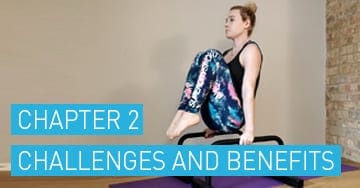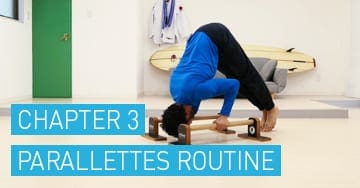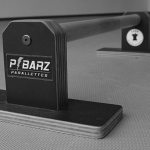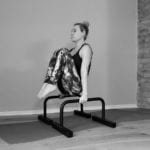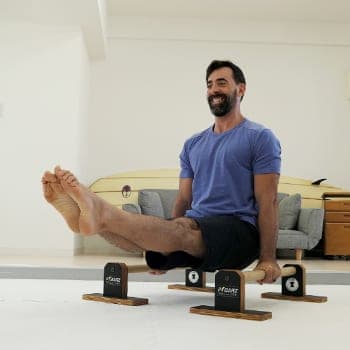 If you’ve never trained with parallettes, you’re missing out!
If you’ve never trained with parallettes, you’re missing out!
These small, portable, parallel bars (also called p-bars) are incredible tools for building upper body and core strength, and they can help you work your way to some pretty cool skills.
In this 6-part guide, we’ll give you everything you need for success with the p-bars:
- In chapter one (the chapter you’re reading right now!), you’ll get an overview of training with parallettes, with a particular emphasis on parallettes for beginners, and how they can be helpful, as well as technical setup recommendations.
- In chapter two, we’ll go over the benefits of training with parallettes, common challenges that come up, and how to overcome those challenges.
- Chapter three is a full parallettes routine you can start working on right away.
- In chapter four, we’ll look at how parallettes can specifically help you build bent arm pressing strength with exercises like push-ups and dips.
- Chapter five explores using parallettes for straight arm strength, with exercises like handstands and L-sits.
- Finally, in chapter six, we’ll give you two options for building your own parallettes, plus a recommendation for our favorite parallettes on the market.
As you can see, we’ve got a lot to cover! Feel free to peruse the parts of this guide that speak to your interests and goals most strongly, or read through the guide chapter-by-chapter. As you read through this guide, you can always find chapter links at the top and bottom of each page.
Let’s get into it!
Beginner Parallettes Training and What You Need to Know
Since most people have never even heard of parallettes, let alone trained with them, we get a lot of questions about things like setup, height of p-bars, and other technical questions about how to get the most out of this versatile tool.
I’ll walk you through everything you need to know in this video:
We’ll look at the benefits of training with parallettes in more detail in the next chapter, but here’s an overview of some of the other important points from the video.
- Correct Hand Position–Start by placing your thumb on the top of the p-bars, facing forward. Then wrap the fingers and the thumb around the parallettes. Your wrist should be completely straight (neutral), not bent to the outside or inside of the p-bars.
- Width and Dimensions of Parallettes–You have 3 options for setting up the width of your p-bars: narrow (measure the distance between your elbow and your wrist), medium (measure the distance between your elbow and the end of your fist), and wide (measure the distance between your elbow and your fingertips). Medium is a good place to start.
- How High Should Your Parallettes Be?–There’s no defined height we recommend for all people because it’s a matter of preference and level. Taller p-bars (the more standard option) are generally better if you’re just starting out, though they can make hand balancing skills more challenging later on. Lower p-bars are more challenging for skills lower to the ground, but can make hand balancing skills more accessible.
- What are the Best Types of Parallettes?–This is also a matter of preference. We prefer wood p-bars (we recommend these awesome parallettes from our client Dusty), but some people like the feel of metal or PVC instead–they’re all good options. We do not recommend using push-up handles or dumbbells as p-bars, though, as they are not stable enough.
Parallettes for Beginners: The Perfect Gateway to Bodyweight Skills
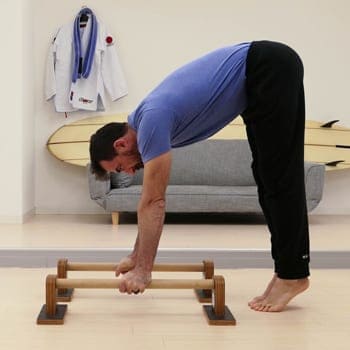 Training with parallettes can be especially helpful for beginners who have little experience with bodyweight training.
Training with parallettes can be especially helpful for beginners who have little experience with bodyweight training.
The leverage afforded by the parallettes can relieve a lot of pressure that might otherwise cause discomfort if you’re not used to supporting your own bodyweight through your hands, shoulders, and torso. So if you’re just getting started with bodyweight training, working with parallettes for a while can help you ease in to things.
And even if you’re not brand new to bodyweight training, having just a bit of space from the ground can help you work up to skills like the L-Sit and inverted press.
Working on skills like those (and many others) tends to be much more challenging the lower you get to the ground.
Ready to Begin Your Parallettes Journey?
Now that you’ve got a basic understanding of proper setup for your p-bars, and setting yourself up for success, let’s get you going on your parallettes journey!
Want to go even further with your p-bar training? Check out our Parallettes One courses.

